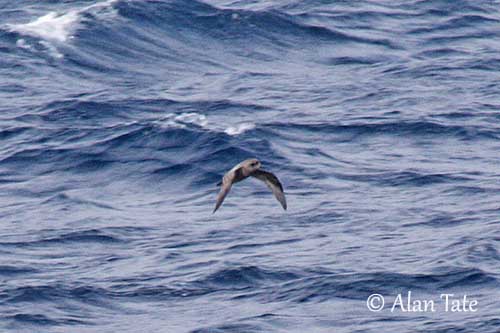
Fr: Pétrel des Kerguelen
Ang: Kerguelen Petrel
All: Kerguelensturmvogel
Esp: Petrel de las Kerguelen
Ita: Petrello delle Isole Kerguelen
Nd: Kerguelenstormvogel
Sd: Kerguelenpetrell
Photographer:
Alan & Ann Tate
AA Bird Photography
Text by Nicole Bouglouan
Sources:
HANDBOOK OF THE BIRDS OF THE WORLD vol 1 by Josep del Hoyo-Andrew Elliot-Jordi Sargatal - Lynx Edicions - ISBN: 8487334105
A Complete Guide to Antarctic Wildlife by Hadoram Shirihai and Illustrated by Brett Jarrett - Edited by Guy M. Kirwan - ALUL.A Press Oy, Finland - ISBN 9519894705
BirdLife International (BirdLife International)
Department of Sustainability, Environment, Water, Population and Communities
Wikipedia, the free encyclopaedia
A new genus for the Kerguelen Petrel by Storrs L. Olson
Kerguelen Petrel
Aphrodroma brevirostris
Procellariiformes Order – Procellariidae Family
INTRODUCTION:
The Kerguelen Petrel is sometimes included in the genus Pterodroma with other gadfly-petrels, but it is now the sole member of the genus Aphrodroma (or Lugensa), and often described as “taxonomic oddball”.
It was regarded to be genetically distinct and closely related to fulmarine petrels and close to shearwaters. This species has very much compressed bill on the sides, and this physical feature is a diagnostic character for a new genus.
DESCRIPTION OF THE BIRD:
Biometrics:
Length: 34 cm
Wingspan: 80-82 cm
Weight: 350 g
The adult is uniformly dark. It has slate grey head and upperparts, including upperwing and tail, although tertials and innermost greater and median coverts are slightly darker.
The underparts are slate grey, often slightly paler than upperparts. The slate grey underwing is darker on most coverts, but it may appear silvery at base of primaries and greater coverts while reflecting low sunlight.
In worn plumage, the belly appears paler and blotched, and an indistinct hood can be seen from below.
The Kerguelen Petrel is a stocky bird with large head and small, black bill that may appear very narrow from above. The eyes are dark brown. Legs and webbed feet are blackish-grey to pinkish-grey.
Male and female have similar plumage, but the male is slightly larger overall.
The juvenile resembles adults.

RANGE:
The Kerguelen Petrel is highly pelagic and occurs in Southern Ocean. It breeds on several subantarctic islands including Gough, Prince Edward, Marion, Crozet and Kerguelen Islands, and probably Tristan da Cunha.
HABITAT:
The Kerguelen Petrel breeds in colonies established near the sea on flat or gently sloped tundra, or on slopes covered with tussock grass. It nests in self-excavated burrow.
Outside the breeding season, it is marine and pelagic, and occurs mainly in cold waters.
CALLS AND SONGS:
The Kerguelen Petrel is usually silent at sea where it is often solitary. At colonies, this species is relatively quiet, only giving wheezy “chee-chee-chay” while flying over the burrows. Some higher-pitched, more drawn-our sounds can be heard too.
BEHAVIOUR IN THE WILD:
The Kerguelen Petrel feeds mainly on squid (Gonatus antarcticus), some fish and crustaceans, especially krill of genus Euphausia, and cephalopods.
Squid is caught at night by surface-seizing, but it also performs dipping and surface-plunging. It may associate with cetaceans that lead the preys close to the surface.
It is usually solitary at sea, but it may take part to exuberant chases if numerous seabirds are present. However, small groups of 4-5 birds congregate at food sources. It shows little interest in ships.
When feeding in open waters around Antarctica, it can be seen with Cape Petrel, Blue Petrel and Antarctic Prion.
The Kerguelen Petrel is nocturnal at colonies, although it may sometimes visit them by day. They are monogamous. They breed in colonies and only defend the burrow. The laying occurs in October, after a pre-laying exodus of four weeks in September.
The Kerguelen Petrel adults may visit the colonies all year round. They frequent subantarctic and Antarctic waters S to pack ice throughout the year.
It disperses widely S through Southern Ocean N to 40°S, sometimes to South Africa, Australia and New Zealand. It may occasionally disperse as far as the Falklands and South Georgia.
The Kerguelen Petrel performs a spectacular fast flight in strong winds, often in high sweeping arcs and long glides. It may hover in Falco-like fashion at 20-30 metres above the water.
REPRODUCTION OF THIS SPECIES:
The breeding season takes place between August and January/February, with the egg-laying in October.
The Kerguelen Petrel breeds colonially on tussock-covered slopes with soft, wet soil in which it digs the long burrow (0,80-2,80 metres) lined with vegetation. The entrance is sheltered by tussock grass from strong winds.
The female lays a single white egg. The incubation lasts 46-51 days, shared by both adults in long stints of 10-15 days.
At hatching, the chick is covered with sooty-brown down. It is brooded for the first two days. Both parents feed it and it fledges about 59-62 days after hatching.
This species produces a single brood per season.
PROTECTION / THREATS / STATUS:
The Kerguelen Petrel has wide range in which it is abundant. There is extensive predation by rats and cats in Crozet Islands, whereas skuas and dogs take some birds at Gough and Tristan da Cunha.
The global population was estimated at about 1,000,000 individuals in 2004, and appears to be stable.
The Kerguelen Petrel is currently evaluated as Least Concern.